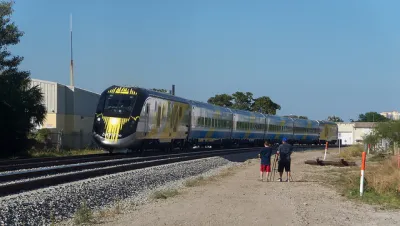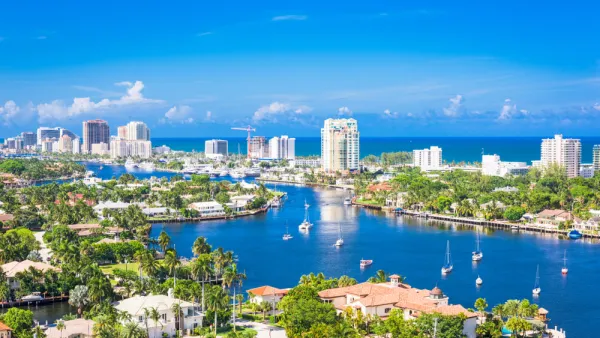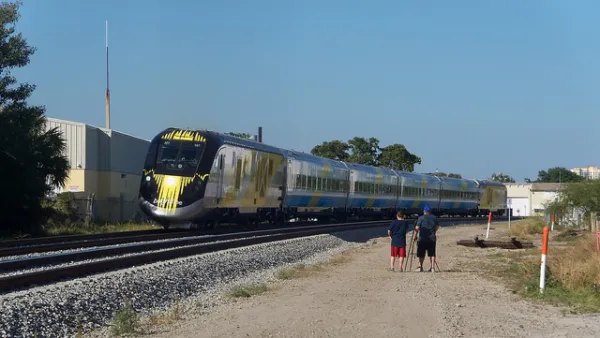The privately funded, diesel-powered trains will run at speeds up to 79 mph between West Palm Beach and Fort Lauderdale, with an extension to Miami opening early next year. Real estate development is key to profitability.

"The ambitious $3 billion Brightline express project will run along the state's densest population corridor with more than 6 million residents and a regular influx of tourists," reports Samantha Raphelson for WBUR News on Dec 7. According to the WBUR map [jpg], the trip from West Palm Beach to Fort Lauderdale will take 30 minutes and another 30 minutes to Miami when service begins.
The project, funded by All Aboard Florida, represents the first test into the long-awaited U.S. move into high-speed rail, says John Renne, director of the Center for Urban and Environmental Solutions at Florida Atlantic University.
Brightline is 'higher-speed rail,' not high-speed rail, which would require electrification (includes maglev rail) and grade separations at speeds above 125 mph, according to the Federal Railroad Administration. An extension to Orlando will enable speeds up to 125 mph. The trains will be powered by EPA Tier 4 compliant locomotives manufactured in Siemens' Sacramento, Calif. plant, which will also built the passenger cars.
"It's the first time that it's happening, being built by a private company," [Renne] tells Here & Now's Jeremy Hobson. "And that's kind of a game changer for this type of model."
“On a national level, the scale of impact could be enormous. It’s a proof of concept for private financing corridor-based infrastructure,” says Adie Tomer, a fellow at the Brookings Institution Metropolitan Policy Program, in a piece by Chris Persaud in Next City on Oct 23, 2017.
Profits to come from real estate, not train tickets
Beyond slashing travel times, Renne says the construction of private mixed-use real estate developments at each station will bring in hundreds of millions of dollars in new revenue. He explains that potential revenue was lost when the government shifted control of transportation to the public sector in the 1920s [or 30s].
When that happened, we lost the connection between the development around the stations and the rail service itself, and we started building a lot of parking lots around the stations," he says. [Renne expands on the relationship between real estate development and train profitability in the audio version].
"The research shows that the transportation service itself rarely makes a profit," he says. "But when you combine the real estate and development opportunities with the transportation service, you can ... actually get to a very profitable outcome."
Unlike the nation's two high-speed rail projects in Texas and California, Brightline will operate in a corridor already owned by All Aboard Florida's parent company, Florida East Coast Industries. "The return to passenger trains will revive a line that stopped running on those old tracks in the 1960s, with the arrival of the federal highway program," writes Raphelson.
Opposition
Like it's semi-counterpart in California, the rail line has sparked litigation by jurisdictions in the corridor. "Two counties along the wealthy Treasure Coast sued to stop the Brightline project, arguing it poses significant safety concerns and would likely delay commuters in cars," adds Raphelson. "Most of those lawsuits have been tossed out or dropped."
The boating industry has also raised objections due to the requirement that drawbridges remain down for trains to use them.
Fares
A 2015 study commissioned by the company suggests it will cost at least $16 to travel from West Palm to Miami – about $10 more than the price to travel a similar route on South Florida's government-run passenger train.
Renne is also extensively quoted in the October Next City piece that goes into much greater depth on the political opposition, and support, along the Treasure Coast.
FULL STORY: Florida Set To Launch Country's First Private High-Speed Train Service

Analysis: Cybertruck Fatality Rate Far Exceeds That of Ford Pinto
The Tesla Cybertruck was recalled seven times last year.

National Parks Layoffs Will Cause Communities to Lose Billions
Thousands of essential park workers were laid off this week, just before the busy spring break season.

Retro-silient?: America’s First “Eco-burb,” The Woodlands Turns 50
A master-planned community north of Houston offers lessons on green infrastructure and resilient design, but falls short of its founder’s lofty affordability and walkability goals.

Test News Post 1
This is a summary

Analysis: Cybertruck Fatality Rate Far Exceeds That of Ford Pinto
The Tesla Cybertruck was recalled seven times last year.

Test News Headline 46
Test for the image on the front page.
Urban Design for Planners 1: Software Tools
This six-course series explores essential urban design concepts using open source software and equips planners with the tools they need to participate fully in the urban design process.
Planning for Universal Design
Learn the tools for implementing Universal Design in planning regulations.
EMC Planning Group, Inc.
Planetizen
Planetizen
Mpact (formerly Rail~Volution)
Great Falls Development Authority, Inc.
HUDs Office of Policy Development and Research
NYU Wagner Graduate School of Public Service



























